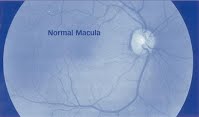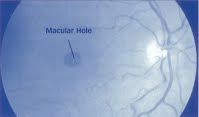Macular Hole
All information taken from the American Academy of Ophthalmology’s Eye Facts Pamphlet.
The macula is the central area of one of the most important parts of your eye-the retina. The retina is a thin layer of light-sensitive tissue that lines the back of the eye. Light rays are focused onto the retina, where they are transmitted to the brain and interpreted as the images you see. The macula is the portion of the retina responsible for clear, detailed vision.
 How does a macular hole form?
How does a macular hole form?
Your eye is filled with a gel-like substance called vitreous, which lies in front of the macula. As you age, the vitreous gel shrinks and pulls away from the macula, usually with no negative effect on your sight. In some cases, however, the vitreous gel sticks to the macula and is unable to pull away. As a result, the macular tissue stretches. After several weeks, or months, the macula tears forming a hole.
 What are the symptoms of a macular hole?
What are the symptoms of a macular hole?
In the early stages of hole formation, your central vision becomes blurred and distorted. If the hole progresses, a blind spot develops in your central vision and impairs the ability to see at both distant and close range.
It is important to note that if the macula is damaged you will not lose your vision entirely. You will still have peripheral or side vision.
What tests will be performed?
Your ophthalmologist (Eye M.D.) will diagnose a macular hole by looking inside your eye with special instruments. Your ophthalmologist may use a test called Optical Coherence Tomography, or OCT, to scan and examine your retina. OCT uses light waves to reveal specific layers of the retina.
How is a macular hole treated?
Vitrectomy surgery is the most effective treatment to repair a macular hole and possibly improve vision. The surgery involves tiny instruments to remove the vitreous gel that is pulling on the macula. The eye is then filled with a special gas bubble to help flatten the macular hole and hold it in place while it heals.
You must maintain a constant face-down position after surgery to keep the gas bubble in contact with the macula. This can range from a few days to a few weeks, depending on your surgeon’s recommendation. A successful result often depends on how well this position is maintained. The bubble will then slowly dissolve on its own.
Do not fly in an airplane or travel at high altitudes until the gas bubble has dissolved. A rapid increase in altitude can cause a dangerous rise in eye pressure.
You can expect some discomfort after surgery. You will need to wear an eye patch for a short time. Your ophthalmologist will prescribe eyedrops for you and advise you when to resume normal activity.
As the macular hole closes, the eye slowly regains part of the lost sight. The outcome for vision may depend on the size of the hole and how long it was present before surgery. The amount of visual recovery can vary.
What are the risks of macular hole surgery?
Some of the risks of vitrectomy include:
- infection of the eye
- bleeding of the eye
- retinal detachment
- high pressure in the eye
- poor vision
- accelerated cataract formation
It is important that you discuss the potential risks and benefits of this procedure with your ophthalmologist before making a decision regarding treatment.
Macular Hole. Eye Facts. (2008). American Academy of Ophthalmology. San Francisco, CA.



